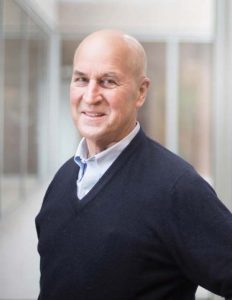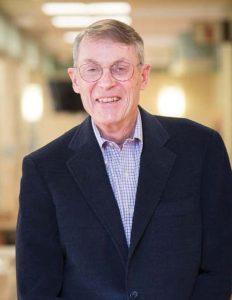Gifts fund research to develop new & better cure
June 2, 2016 | Bill Snyder
For patients with myelodysplastic syndromes (MDS), the only chance for a cure is stem cell transplantation: a massive dose of chemotherapy to kill their diseased bone marrow, followed by an infusion of stem cells from a healthy donor to replace it.
With a success rate of 40 percent, it’s far from a sure thing.

Tommy Boyle, who benefited from a stem cell transplant at Vanderbilt-Ingram Cancer Center, supports MDS research. Photo by Susan Urmy.
Tommy Boyle, 64, received a stem cell transplant at Vanderbilt-Ingram Cancer Center (VICC) in October 2015, two years after being diagnosed with MDS. So far, the cancer has not returned. “I hope I will be one of the lucky ones,” he said.
In gratitude for the care he received at Vanderbilt, Boyle and his wife, Mimi, established an endowment at VICC, funded a discovery research grant, and have agreed to serve on the Cancer Center’s Board of Overseers.
“I’ll think we’ll be good ambassadors,” he said. “When you believe in something, it’s easy to represent it.”
Larry Adelman wasn’t so fortunate.
The 69-year-old corporate consultant “had been vigorous, healthy, athletic, good-looking, vivacious, outgoing, financially and personally successful in any and every way I could think of,” said his long-time friend, Roger “Biff” Ruttenberg, co-founder and principal of Atlas Partners investment firm in Chicago.
Then he developed MDS. Adelman opted for stem cell transplantation. Unfortunately, he did not survive the blast of chemotherapy long enough for his bone marrow to be replenished. He died in May 2015.
In his grief, Ruttenberg decided to try to increase the odds for future patients by investing in research through the non-profit foundation that bears his name.
That’s how he, his wife, Gwen Callans, and longtime associate Dawn Stevenson discovered VICC. They decided to contribute toward research conducted by Melanie D. Ohi, Ph.D.
“One of the things I do with the capital that I have is to invest in early-stage and start-up deals,” Ruttenberg said. “It’s seed capital, angel investing.”

Clarence Thomas, who did not qualify for a stem cell transplant because of his age, participated in a clinical trial of two drugs. His MDS is now in remission. Photo by Susan Urmy.
Michael Lewis, Ph.D., the president of the Edward P. Evans Foundation, agreed. “Our desire is not to grow fruit, but to plant the seeds and to help them grow,” he said. “We’re there to get people started … The role of a foundation in jumpstarting new therapies is really important.”
Clarence Thomas, M.D., is living proof of the value of this approach. The retired Nashville cardiovascular surgeon didn’t qualify for a stem cell transplant when he was diagnosed with MDS three years ago because of his age—he was 77.
Fortunately, Michael Savona, M.D., director of Hematology Research at VICC, had begun a clinical trial to test the effectiveness of two drugs, taken orally. One drug restores normal gene function, while the other prevents the first drug from being broken down in the gut and liver.
Thomas joined the trial and the drug combo put him into complete remission. “He’s done remarkably well,” Savona said.
Now 80 and an avid kayaker, Thomas moved recently to Richmond, Virginia, to be closer to his daughter after a year of therapy. He was able to transfer to the Phase 1 study at Johns Hopkins University Medical Center in Baltimore.
“My white count, which is the crucial issue with me, is holding with no complications,” he said. “I’m hoping very much I can be maintained on this therapy for as long as possible.”
